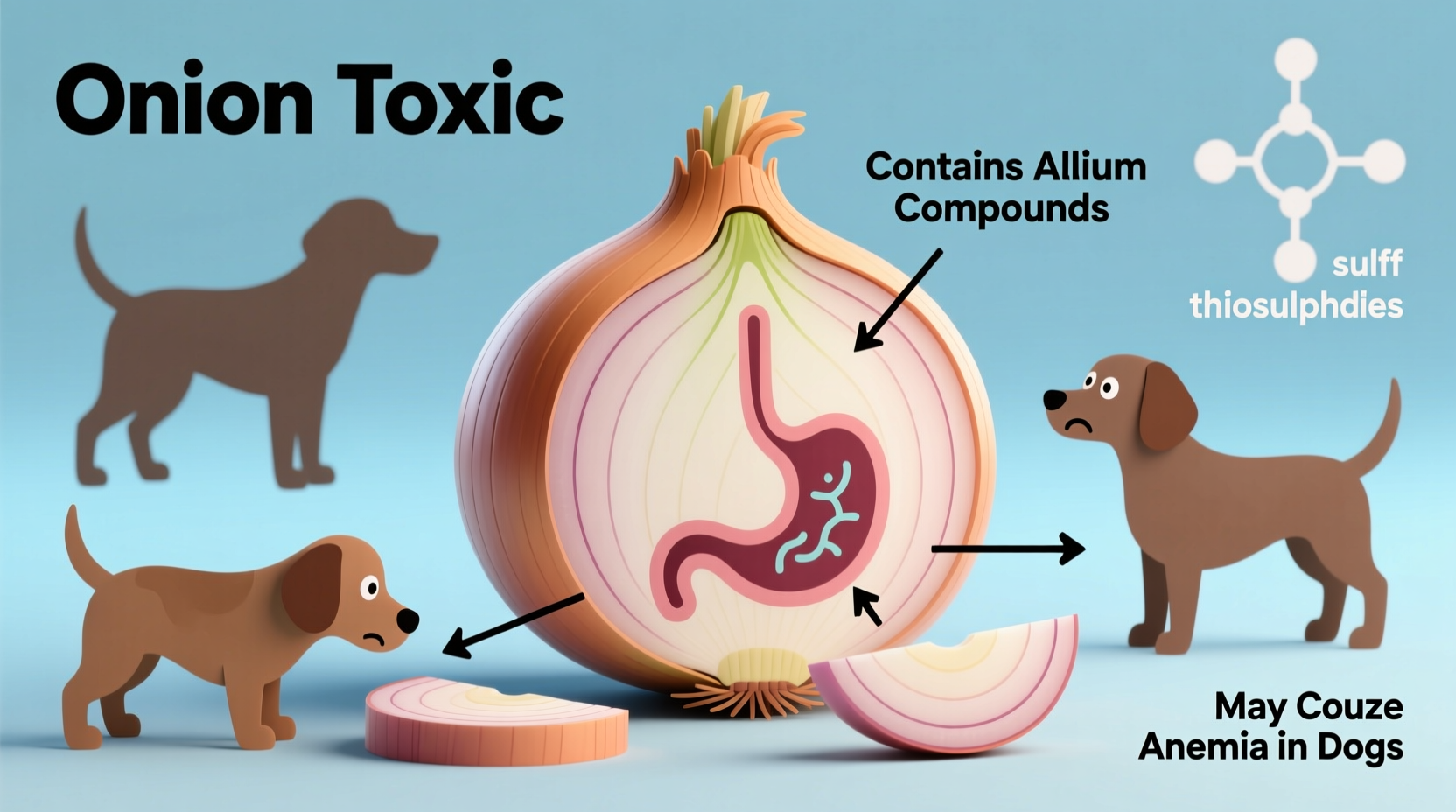Yes, onions are toxic to dogs in all forms—raw, cooked, powdered, or in broth. Even small amounts can cause life-threatening hemolytic anemia by damaging red blood cells. This article explains exactly how onion toxicity works in dogs, the dangerous thresholds by weight, symptoms to watch for, and immediate steps to take if your dog ingests onions.
If you've ever wondered whether it's safe to share your meal with your canine companion, understanding onion toxicity in dogs is critical knowledge for every pet owner. Onions aren't just an unpleasant flavor for dogs—they represent a serious health hazard that requires immediate attention if ingestion occurs.
The Science Behind Onion Toxicity in Dogs
Unlike humans, dogs lack the metabolic pathway to safely process N-propyl disulfide, the sulfur compound found in all Allium family members (onions, garlic, leeks, chives). This compound oxidizes hemoglobin in red blood cells, causing them to rupture—a condition called hemolytic anemia.
When red blood cells break down faster than the body can replace them, dogs experience oxygen deprivation that affects every organ system. The damage occurs at the cellular level, meaning symptoms might not appear immediately but can become severe within 24-72 hours.

How Much Onion Is Dangerous for Dogs?
The toxic threshold depends on your dog's size and the onion form. Research from the ASPCA Animal Poison Control Center shows that as little as 15-30 grams of onions per kilogram of body weight can trigger toxicity.
| Dog Weight | Raw Onion Toxic Dose | Garlic Toxic Dose | Onion Powder Equivalent |
|---|---|---|---|
| 10 lbs (4.5 kg) | 2-3 tablespoons | 1-2 cloves | 1 teaspoon |
| 30 lbs (13.6 kg) | 6-9 tablespoons | 3-5 cloves | 1.5 teaspoons |
| 60 lbs (27.2 kg) | 12-18 tablespoons | 6-10 cloves | 3 teaspoons |
This onion toxicity chart for dogs demonstrates why even small kitchen scraps can be dangerous. Note that garlic contains higher concentrations of thiosulfates (5 times more potent than onions), making it particularly hazardous.
Symptoms of Onion Poisoning: What to Watch For
Onion toxicity symptoms typically appear 1-3 days after ingestion as damaged red blood cells accumulate. Early signs include:
- Weakness and lethargy (most common initial symptom)
- Vomiting and diarrhea
- Decreased appetite
- Pale gums
- Rapid breathing
As toxicity progresses, you might notice:
- Red or brown urine (from hemoglobin release)
- Jaundice (yellowing of eyes and gums)
- Increased heart rate
- Collapse from severe anemia
Remember that onion poisoning in dogs timeline varies—some dogs show symptoms within hours, while others may take days to exhibit signs despite significant internal damage.
Immediate Actions: What to Do If Your Dog Ate Onions
If you witness your dog consuming onions or notice them in vomit, take these steps immediately:
- Calculate the amount ingested relative to your dog's weight using the toxicity chart above
- Contact your veterinarian or animal poison control (ASPCA: (888) 426-4435) immediately—don't wait for symptoms
- Do not induce vomiting unless specifically instructed by a professional
- Bring the packaging or remaining food to help veterinarians identify the exact onion form and quantity
Veterinary treatment may include intravenous fluids, oxygen therapy, blood transfusions for severe anemia, and medications to support red blood cell production. Early intervention dramatically improves recovery chances for dogs who ate onions.
Hidden Sources of Onions: Prevention Strategies
Many dog owners don't realize onions lurk in common foods beyond obvious sources. Watch for these hidden onion threats:
- Processed human foods (baby food, soups, gravies)
- Leftovers containing onion powder (often in "no onion" labeled products)
- Homemade broth or stock
- Seasoned meats and sausages
- Some commercial dog foods with onion derivatives
When reading labels, watch for these onion aliases: dehydrated onions, onion powder, onion salt, shallots, leeks, chives, and any ingredient starting with "allium". The Cornell University College of Veterinary Medicine confirms that no amount of onion is considered safe for canine consumption.
Safe Flavor Alternatives for Dogs
If you're preparing homemade meals for your dog, consider these safe flavor enhancers instead of onions:
- Parsley (fresh, in moderation)
- Carrots (cooked or raw)
- Green beans
- Small amounts of basil or oregano
- Pumpkin (pure, not pie filling)
Always consult your veterinarian before introducing new ingredients to your dog's diet, especially if they have pre-existing health conditions that might affect onion toxicity risk factors for dogs.
Frequently Asked Questions About Onion Toxicity in Dogs
Can dogs eat small amounts of onion without harm?
No amount of onion is considered safe for dogs. While larger dogs might tolerate tiny amounts without immediate symptoms, cumulative exposure causes progressive red blood cell damage. The ASPCA confirms there is no established safe threshold for onion consumption in dogs.
How long after eating onions will my dog show symptoms?
Symptoms typically appear 24-72 hours after ingestion as damaged red blood cells accumulate. Some dogs show initial vomiting within hours, but the most dangerous effects (anemia) develop gradually. Monitor your dog for 4-5 days after suspected exposure.
Is cooked onion less toxic to dogs than raw onion?
No, cooking doesn't reduce onion toxicity. In fact, cooked onions and onion powder are often more concentrated, making them potentially more dangerous. All forms of onions—raw, cooked, dehydrated, or powdered—contain the toxic compounds that damage dogs' red blood cells.
Can onion toxicity be reversed in dogs?
With prompt veterinary treatment, most dogs recover from onion toxicity. Treatment focuses on supportive care while the body replaces damaged red blood cells. Severe cases requiring blood transfusions have good recovery rates when treated immediately. However, permanent organ damage can occur if anemia is left untreated.
Are certain dog breeds more sensitive to onion toxicity?
Yes, Japanese breeds like Shiba Inus and Akita Inus show increased sensitivity to onion compounds due to genetic factors affecting red blood cell structure. However, all dog breeds are susceptible to onion toxicity regardless of size or breed.











 浙公网安备
33010002000092号
浙公网安备
33010002000092号 浙B2-20120091-4
浙B2-20120091-4